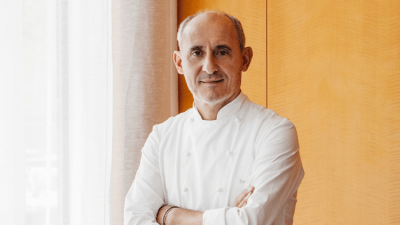Comment
The Michelin Guide: why it leaves me wanting more

The dust has settled after Michelin’s announcement of its newly starred restaurants earlier this week. Great Britain and Ireland finally has a fifth three-star place to celebrate - and by GB I mean London and its environs - with The Araki bagging the top accolade from the red book.
The fact that Michelin decided to hand out another of its all-too-rare top gongs to a London restaurant was something of a surprise given that the last time it did it went to Alain Ducasse in its 2010 guide (not counting The Fat Duck’s reinstatement as a three-star restaurant last year), but that it went to the nine-seat counter spot in Mayfair was less so. Having spoken to many Michelin-starred chefs over the past few years about which UK restaurant, if any, would be next to get three stars, The Araki’s name came up time and again (it entered straight in with two stars in the 2016 guide and chef Mitsuhiro Araki held three stars in Tokyo).
It’s also no surprise that Claude Bosi has entered the guide with two stars with Bibendum, the restaurant he took on after closing Hibiscus. Bosi didn’t hide the fact that he wanted to at least regain the two stars he held at Hibiscus, and push for more in the future, and judging by the excellent meal I had there it is well deserved. Of all the current two-star chefs in the UK, Bosi is my favourite to win a third in the coming years.
That Michelin-starred chefs correctly saw The Araki as a three-star restaurant, and that Bosi was able to win two stars for his cooking first time round at Bibendum, shows that chefs who have had a star or two bestowed on them are well versed in what the red book looks for when it awards its stars - even if the general public is less clear on the matter. Many of the new one-star editions in the 2018 guide have been awarded to chefs who have previously held stars at different restaurant, or who hold them at other establishments already. Some chefs may not cook for stars, but they know how to cook to get them.
This isn’t meant to sound negative, it is merely an observation. As someone who was involved with the World’s 50 Best Restaurants for a long time, and who oversees Restaurant magazine’s own National Restaurant Awards, I know what it’s like to have people pick apart something you have invested a lot of time and effort on. But it does go some way to trying to understand what makes a restaurant worthy of a star or not.
Michelin says it awards one star for a restaurant deemed to offer very good cooking in its category; two stars for a place serving excellent cooking and that is worth a detour; and three stars to a place of exceptional cuisine, worthy of a special journey. But it’s not as simple as that. More often that not, Michelin inspectors gravitate to a certain style of cooking and plating when considering what is good, excellent and exceptional, excluding those restaurants that don’t fit with this style.
Given Michelin’s attempts in recent years to recognise the brilliant cooking being found in more informal establishments, what is noticeable in this year’s guide is just how few new casual places have been rewarded with a star. And those places that could be deemed more casual - notably The Coach in Marlow and Paco Tapas in Bristol - are overseen by Michelin-starred chefs. Both places are excellent, and star worthy, but are by no means the only new examples of brilliant cooking in casual surrounds.
Instead, Michelin seems to save more casual places for its Bib Gourmands, which takes into account price as well as food quality. To win a Bib Gourmand is a fine achievement, but by creating this award there’s almost a feeling that these places are too good value to win a star proper.
Whether you agree with Michelin’s awarding of stars to certain restaurants isn’t the point - one person’s best meal is another person’s worst as a quick glance at TripAdvisor shows - Michelin seems, in the main, to still reward very Michelin style restaurants.
One reason for this might be consistency. Consistency is, of course, key to any restaurant business - you don’t want customers at different tables having a completely different experience of the same menu - but it is possibly even more important for the guide’s inspectors, who can assiduously review a place two or three times before casting their verdict. This is A Good Thing. But a side effect of that means that chefs seeking recognition for the red book are often turning to techniques that put consistency before flavour (waterbaths, I’m looking at you) and plating styles that mirror each other’s.
Another reason could be resources. With so many restaurants around the country, it can’t be physically or financially possible to visit each one, and chefs that are already on Michelin’s radar have an advantage. Can there really be no new good value restaurants in Scotland worthy of a Bib Gourmand, and only one in Wales for that matter?
Today’s eating out scene has never been more exciting, and Michelin does a sterling job in acknowledging those chefs that cook within its framework of excellence. But it’s time the red book broadened that framework and used its heritage, expertise and rigour to celebrate the wider industry beyond fine dining. This can’t be done overnight, as there is an expectation among readers of the guide of the kind of places it rewards but, nevertheless, Michelin has the power to do this.
Unlike awards - such as Restaurant’s own - that seek countless personal opinions on what makes a good restaurant (and get valuable and varied results in the process) Michelin closely controls its inspection criteria. Thus it can reassess what really makes a restaurant worthy of a detour in 2017 and beyond.















